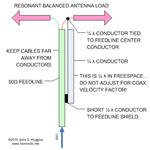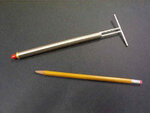drkirkby
Full Member level 6

It is possible to make a balun with a 1:1 impedance transformation from coaxial cable?
This article
https://www.iw5edi.com/ham-radio/files/I0QM_BALUN.PDF
Coaxial balun by the radio amateur I0QM, claims to give a 1:1 balun from coax. However, I am highly suspicious of the validity of the arguments given. He uses two sections of transmission line (one λ/4, the other 3λ/4), to achieve a 180 degree phase difference. Well why not just use one bit of coax, of λ/2, or if more convenient, 0.1λ and 0.6λ?
Then it says "As the electrical length of both sections include the ¼ wavelength coaxial transformer, and if the unbalanced impedance has the same value of the coaxial cable, then the impedance seen at the other extremes is exactly the same value." Well, if the impedances are the same, we don't need any coaxial transformer.
So basically, unless I'm mistaken, this article is seriously flawed, in its technical arguments, although I'm not saying the design does not work.
This article
https://www.qsl.net/i0jx/balun.pdf
basically has the same design.
I've tried searching with Google Scholar to find peer-reviewed 1:1 coax balun, and can't seem to find anything.
Baluns are a bit of a black-art to me. There seems to be 100's of people writing about them, but I doubt 1% know what they are talking about. It's finding the 1% that is hard!
Dave
This article
https://www.iw5edi.com/ham-radio/files/I0QM_BALUN.PDF
Coaxial balun by the radio amateur I0QM, claims to give a 1:1 balun from coax. However, I am highly suspicious of the validity of the arguments given. He uses two sections of transmission line (one λ/4, the other 3λ/4), to achieve a 180 degree phase difference. Well why not just use one bit of coax, of λ/2, or if more convenient, 0.1λ and 0.6λ?
Then it says "As the electrical length of both sections include the ¼ wavelength coaxial transformer, and if the unbalanced impedance has the same value of the coaxial cable, then the impedance seen at the other extremes is exactly the same value." Well, if the impedances are the same, we don't need any coaxial transformer.
So basically, unless I'm mistaken, this article is seriously flawed, in its technical arguments, although I'm not saying the design does not work.
This article
https://www.qsl.net/i0jx/balun.pdf
basically has the same design.
I've tried searching with Google Scholar to find peer-reviewed 1:1 coax balun, and can't seem to find anything.
Baluns are a bit of a black-art to me. There seems to be 100's of people writing about them, but I doubt 1% know what they are talking about. It's finding the 1% that is hard!
Dave











